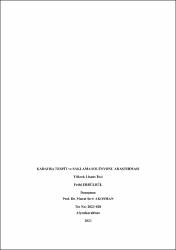| dc.contributor.advisor | Akosman, Murat Sırrı | |
| dc.contributor.author | Erbülbül, Fethi | |
| dc.date.accessioned | 2023-11-15T13:02:50Z | |
| dc.date.available | 2023-11-15T13:02:50Z | |
| dc.date.issued | 03.11.2023 | en_US |
| dc.date.submitted | 2023-10-16 | |
| dc.identifier.uri | https://hdl.handle.net/11630/11341 | |
| dc.description.abstract | Sağlık bilimlerinde kadavra eğitimi öğrencinin mesleki açıdan gelişimi için oldukça önemlidir. Kadavra yapılacak bedenlerin kimyasallara tabii tutularak mikroplardan arındırılması ve otolizin sonlandırılmasıyla uzun yıllar kullanılması amaçlanır. Günümüzde bu işlem için en yaygın ve en basit uygulanabilir özelliği olan kimyasal formaldehittir. Her ne kadar yaygın olarak kullanılsa da formaldehitin insan ve çevre üzerinde olumsuz etkileri vardır. Bu problemler bilim insanlarını farklı arayışlar içine itmiştir. Sunulan bu çalışmada formaldehit yerine sağlıklı bir şekilde kullanılabilecek hem bir kadavra tespit hem de bir kadavra saklama solüsyonu araştırılmıştır. Literatür taramaları neticesinde boraks, nitrat, nitrit, gliserin, alkol ve kekik yağı karışımından oluşan bir solüsyon bileşimi oluşturulmuştur. Oluşturulan bu solüsyona 7 adet koyun kalbi konulurken, 7 adet koyun kalbi de kadavra saklamada kullanılan %10’luk formaldehit solüsyonunda iki ay süreyle tespit olması ve saklanması için bekletilmiştir. İlk on gün sonunda kalpler solüsyonlardan çıkartılıp mezbahadan getirilen taze kalp dokusuyla karşılaştırılmış, solüsyonda ki kalbin renk kaybının az olduğu formaldehite bırakılan kalbin renk kaybının ise oldukça fazla olduğu göze çarpmıştır. Histolojik incelemelerde de formaldehit tespitiyle arasında görsel olarak farklılık olmadığı dokunun bütün büyütmelerde net bir şekilde incelenebildiği gözlenmiştir. İki ay sonunda ise solüsyonlar incelendiğinde solüsyonda ki mikrobiyel üremenin herhangi bir bozulmaya yol açmayacak derecede düşük kaldığı göze çarpmıştır. Renk değişimleri formaldehitten daha iyi seviyelerde olurken, tekstür profil analizi değerleri taze kalp dokusuna daha yakın bulunmuştur. Histolojik incelemelerde doku her büyütmede tanınabiliyor olsa da x100’lük büyütme de hücre çekirdeklerinin daha az boya aldığı görülmüştür. Sonuç olarak bu solüsyonun kadavra tespit ve saklama solüsyonu olarak kullanılabileceği ancak üzerinde daha fazla araştırma yapılmasına gerek olduğu kanısına varılmıştır. | en_US |
| dc.description.abstract | Cadaver education in health sciences is very important for the professional development of the student. Dead human or animal bodies are used for cadaver training. It is aimed to be used for many years by exposing the bodies to various chemicals immediately after they die, purifying them from microbes and ending autolysis. The chemical formaldehyde is the most common and most easily applicable chemical for this process today. Although widely used, formaldehyde has negative effects on students, employees and the environment. These problems have pushed scientists into different pursuits. In this study, both a cadaver fixation and a cadaver storage solution that can be used in a healthy way instead of formaldehyde were investigated. As a result of the literature review, a solution composition consisting of a mixture of borax, nitrate, nitrite, glycerin, alcohol and thyme oil was created. While 7 sheep hearts were placed in this created solution, 7 sheep hearts were placed in %10 formaldehyde solution used for cadaver storage during two months. At the end of the first ten days, the hearts were removed from the solutions and compared with the fresh heart tissue brought from the slaughterhouse, it was observed that the color loss of the heart in the solution was low, and the color loss of the heart left in formaldehyde was quite high. In histological examinations, it was observed that there was no visual difference between formaldehyde detection and the tissue could be examined clearly at all magnifications. At the end of two months, when the solutions were examined, it was observed that the microbial growth in the solution remained low without causing any deterioration. Color changes were better than formaldehyde and texture profile analysis values were closer to fresh heart tissue. Although the tissue can be recognized at every magnification in histological examinations, it was observed that the cell nuclei received less dye at x100 magnification. As a result, it was concluded that this solution can be used as embalming and preservation process of the cadaver, but more research is needed to improve it. | en_US |
| dc.description.sponsorship | Bu tez çalışması; Afyon Kocatepe Üniversitesi Bilimsel Proje Araştırmaları Koordinasyon Birimi (BAPK) Tarafından Desteklenmiştir. Proje No: “22.SAĞ.BİL.24” | en_US |
| dc.language.iso | tur | en_US |
| dc.publisher | Afyon Kocatepe, Sağlık Bilimleri | en_US |
| dc.rights | info:eu-repo/semantics/openAccess | en_US |
| dc.subject | Bor | en_US |
| dc.subject | Formaldehit | en_US |
| dc.subject | Kadavra | en_US |
| dc.subject | Kalp | en_US |
| dc.subject | Tespit | en_US |
| dc.title | Kadavra tespit ve saklama solüsyonu araştırması | en_US |
| dc.title.alternative | Observatıon on cadaver fıxatıon and storage solutıon | en_US |
| dc.title.alternative | Observation on cadaver fixation and storage solution | en_US |
| dc.type | masterThesis | en_US |
| dc.department | Enstitüler, Sağlık Bilimleri Enstitüsü, Besin / Gıda Hijyeni ve Teknolojisi Ana Bilim Dalı | en_US |
| dc.authorid | 0000-0002-0274-2679 | en_US |
| dc.relation.publicationcategory | Tez | en_US |
| dc.contributor.institutionauthor | Erbülbül, Fethi | |



















